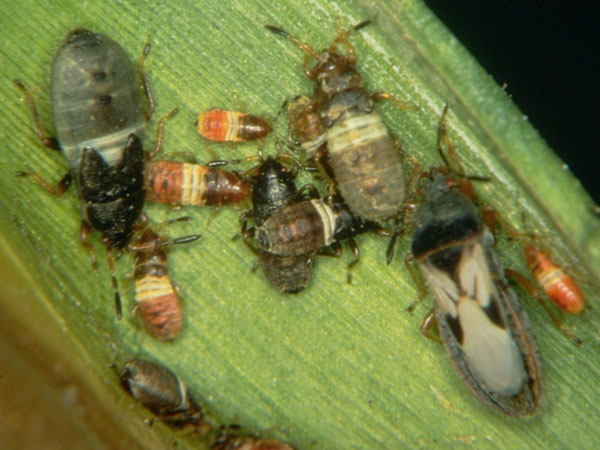Chinch bugs in Kansas are a perennial pest of just about any type of grass (Figure 1). They have caused problems in turf farms, golf courses, and lawns. In crops, they mainly affect sorghum but are occasionally problematic in corn and wheat. Primarily, it is because of timing. As wheat is quickly maturing, chinch bug nymphs, which have been feeding on the wheat until the plants started drying, move elsewhere, seeking a new food source. Often, this is seedling sorghum planted adjacent to those wheat fields that are now maturing but in which the chinch bugs were perfectly happy feeding. This is called the walking migration because these nymphs can't fly or jump. They walk out of the maturing wheat seeking succulent grass to feed on. However, these small nymphs can only live a few days without food and can only walk about 50 yards without finding a suitable food source. Both of these restrictions may be used to help avoid chinch bug damage from this walking migration by delaying planting the area closest to the wheat for a few days.

Figure 1. Adult chinch bug with white "X" on back with young nymphs (red) and older nymphs (grey). Photo by K-State Extension Entomology.
Insecticide-treated seed also helps as the nymphs seem susceptible. However, the bugs need to feed on the plant juice to get the toxin, and if there are too many bugs inserting their mouthparts and sucking out the fluid, especially under less than ideal growing conditions, this may kill the bug, but also kill the plant.
Last year, in 2023, much of Kansas experienced large populations of chinch bugs, so there were potentially large numbers going into the fall/winter; this has caused many questions about chinch bug populations in 2024. In the 1960's-70's, the Kansas Dept. of Ag. conducted overwintering surveys, then sampled fields adjacent to where these overwintering samples were collected in an attempt to predict spring infestation levels. They could not correlate winter diapausing populations with any spring infestations because there are just too many factors that impact these populations. However, we sampled many wheat fields in mid-May this year, and chinch bugs were easily detected. Also, because they float, chinch bugs do not generally drown in heavy rain. So, water running off infested wheat fields moves chinch bugs, often accumulating wherever runoff water pools. Good growing conditions really help plants withstand chinch bug feeding.
As chinch bug infestations are impending, many producers are wondering about the status of chlorpyriphos, a common insecticide widely used for many years. As I understand it, the latest is that the chlorpyriphos ban was lifted in November 2023. Thus, applicators can use it. However, it is again my understanding that supply may be limited because of that recent ban. However, it can be used until June 2025, when new registrations should be issued.
For more information, please refer to the following KSRE publications:
Sorghum Insect Pest Management 2024 MF742 https://bookstore.ksre.ksu.edu/item/sorghum-insect-pest-management-2024_MF742
Chinch Bugs MF3107 https://bookstore.ksre.ksu.edu/item/chinch-bug-kansas-crop-pests_MF3107
Crop Insects of Kansas S-152 https://bookstore.ksre.ksu.edu/item/crop-insects-in-kansas_S152
Jeff Whitworth, Extension Entomology Specialist
jwhitwor@ksu.edu
Tags: insects grain sorghum chinch bugs pests